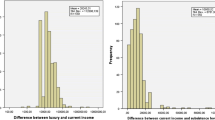Abstract
Prior research has estimated intergenerational time preferences by asking respondents to choose between hypothetical life saving programs. From such choices, researchers have concluded that the public heavily discounts the lives of people in future generations. However, using a multiversion survey involving 401 respondents, I show that imputed intergenerational time preferences can be dramatically affected by the specific question that is asked. Different elicitation procedures can yield widely varying results by evoking or suppressing various relevant considerations (such as uncertainty). Many formats revealed no preference for current generations over future generations.
Similar content being viewed by others
References
Cairns, John. (1994). "Valuing Future Benefits," Health Economics 3, 221–229.
Chapman, Gretchen. (2001). "Time Preferences for the Very Long Term," Acta Psychologica 108, 95–116.
Chichilnisky, Graciela. (1997). "What is Sustainable Development?," Land Economics 73, 467–491.
Cropper, Maureen, Sema Aydede, and Paul Portney. (1991). "Discounting Human Lives," American Journal of Agricultural Economics 73, 1410–1415.
Cropper, Maureen, Sema Aydede, and Paul Portney. (1992). "Rates of Time Preference for Saving Lives," American Economic Review 82, 469–472.
Cropper, Maureen, Sema Aydede, and Paul Portney. (1994). "Preferences for Life Saving Programs: How the Public Discounts Time and Age," Journal of Risk and Uncertainty 8, 243–265.
Dardis, Rachel and Thomas Keane. (1995). "Risk-Benefit Analysis of Cigarette Smoking: Public Policy Implications," The Journal of Consumer Affairs 29, 351–367.
Enemark, Ulrika, Carl Lyttkens, Thomas Troeng, Henrik Weibull, and Jonas Ranstam. (1998). "Implicit Discount Rates of Vascular Surgeons in the Management of Abdominal Aortic Aneurisms," Medical Decision Making 18, 168–177.
Horowitz, John and Richard Carson, T. (1990). "Discounting Statistical Lives," Journal of Risk and Uncertainty 3, 403–413.
Huber, Joel, John Payne, and Christopher Puto. (1982). "Adding Asymmetrically Dominated Alternatives: Violations of Regularity and the Similarity Hypothesis," Journal of Consumer Research 9, 90–98.
Johannesson, Magnus and Per-Olov Johansson. (1997). "Saving Lives in the Present Versus Saving Lives in the Future—Is There a Framing Effect?," Journal of Risk and Uncertainty 15, 167–176.
Loewenstein, George and Drazen Prelec. (1991). "Negative Time Preference," American Economic Review 81, 347–352.
Loewenstein, George and Drazen Prelec. (1993). "Preferences for Sequences of Outcomes," Psychological Review 100, 91–108.
McKie, John. (1999). "Daniels on Rationing Medical Care," Economics and Philosophy 15, 109–117.
Miller, Ted, Diane Lestina, Maury Galbraith, Tim Schlax, Pamela Mabery, and Richard Deering. (1997). "United States Passenger-Vehicle Crashes by Crash Geometry: Direct Costs and Other Losses," Accident Analysis and Prevention 29, 343–352.
Olsen, Jan. (1993). "Time Preferences for Health Gains: An Empirical Investigation," Health Economics 2, 257–265.
Page, Talbot. (1977). Conservation and Economic Efficiency. Baltimore: Johns Hopkins University Press.
Poulos, Christine and Dale Whittington. (2000). "Time Preferences for Life-Saving Programs: Evidence from Six Less Developed Countries," Environmental Science and Technology 34, 1445–1455.
Simonson, Itamar and Amos Tversky. (1992). "Choice in Context: Tradeoff Contrast and Extremeness Aversion," Journal of Marketing Research 29, 281–295.
U.S. Fifth Circuit Court of Appeals. (1991). [See 947 F.2d (5th Cir. 1991)].
Author information
Authors and Affiliations
Rights and permissions
About this article
Cite this article
Frederick, S. Measuring Intergenerational Time Preference: Are Future Lives Valued Less?. Journal of Risk and Uncertainty 26, 39–53 (2003). https://doi.org/10.1023/A:1022298223127
Issue Date:
DOI: https://doi.org/10.1023/A:1022298223127




